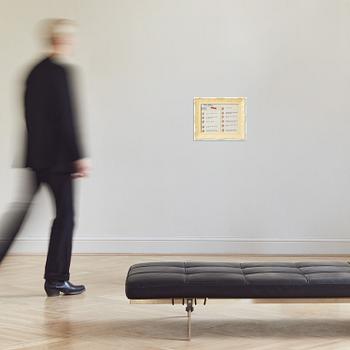Marie-Louise Ekman
'The Mino School of Facial Expressions'
Executed in 1971. Later signed ML Ekman and dated 2019 verso. Gouache and watercolour on canvas 41 x 49.5 cm including frame.
Literature
'Marie-Louise Ekman', 1998, mentioned p. 61, illustrated p. 65.
Marie-Louise Ekman, 'This is not an answer: On the work of Marie-Louise Ekman', 2013, illustrated full-page p. 176-177.
More information
'MARIE-LOUISE IS MY ROLE MODEL. SHE LAUGHS OUT LOUD AND PAINTS IN A WAY THAT IS COMPLETELY UNDERSTANDABLE.'
Helene Billgren
Marie-Louise Ekman's cross-genre practice and attitude are also prominent in her paintings. Although no single expression can accommodate all of Ekman's visions, many of them are activated in her visual art.
For example, the theatre with its references - roles, masks, stage space etc - is a frequent metaphor in Marie-Louise Ekman's art. She summarises parts of theatre expression in the auction's painting, 'The Mino School of Facial Expressions' from 1971, where she presents eleven of the basic mines in theatre. Marie-Louise Ekman formulates it herself on the front of the canvas:
'If you can live, you can also play theatre. One of the most important things in theatre is the mines. Here are some of the most common ones to practice.'
It was in the late sixties that Marie-Louise Ekman made her debut on the art scene. She made her debut at the legendary Galleri Karlsson in 1967, together with her then husband Carl Johan De Geer. The following years followed a period of numerous exhibitions, mainly in Sweden, but also internationally. The painting in the auction, 'The Mino School of Facial Expressions' was made in 1971.
'Life as theatre. The fundamental metaphor in Marie-Louise Ekman's art is the theatre. Theatre is at the same time the most banal and telling image of life imaginable.
'The Mino School of Facial Expressions' is a funny little painting in the form of a spread in a book, or a brochure with instructions for which facial expressions to use, for example when 'You see an earthquake and everyone dies', 'Your father comes towards you with a big mask in his mouth' and 'You dream that you are dead and then when you wake up you are'. The categorisation itself speaks volumes about what life means: 'If you can live, you can also do theatre. One of the most important things in theatre is the mines.'
From the book 'Marie-Louise Ekman', Carlssons förlag, 1998, page 61. Text by Maria Lind.
Artist
Marie-Louise Ekman is without a doubt one of Sweden's most eccentric artists. The consistency in her expression is striking, with a distinctive language that is unmistakably her own.
Ekman's artistry is timeless and continuously relevent. She is a leading and influential artist who often depicts everyday environments, but does not align herself with the absurdist and surrealist art forms. She travels unhindered over artistic buondaries and often ustilises art historical references, incorporating them with pop-culture references. Ekmans konstnärskap har i mycket präglats av hennes anarkistiska och klarsynta angrepp på normalitet som ständigt har manifesterats i en spännvidd som låtit henne ingå i kretsen kring den inflytelserika undergroundtidningen "Puss" och med separatutställningar på Galerie Aronowitsch.
When looking closer at her multifaceted artisty one discovers that she is a recycler. There is barely a motif that is not repeated in more than one context, not a figure that does not stir up déjà vu. One first encounters these elements in objects or paintins, then in movies, tv-seris and radio programmes. Although the media sources vary in theme and tone over the decades, Ekman continues to reference media through her art, and it is thanks to this that Ekman feels forever young.
Read more











































